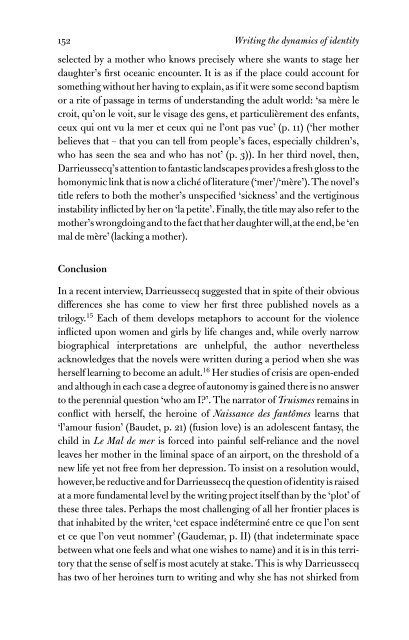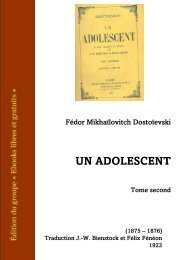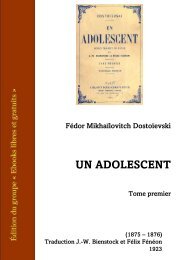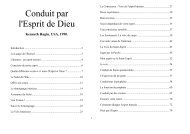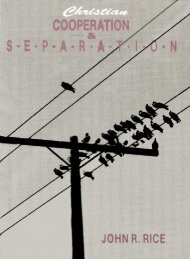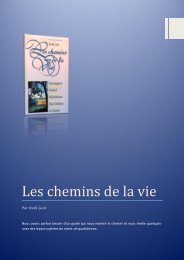Women writing in contemporary France
Create successful ePaper yourself
Turn your PDF publications into a flip-book with our unique Google optimized e-Paper software.
152 Writ<strong>in</strong>g the dynamics of identity<br />
selected by a mother who knows precisely where she wants to stage her<br />
daughter’s first oceanic encounter. It is as if the place could account for<br />
someth<strong>in</strong>g without her hav<strong>in</strong>g to expla<strong>in</strong>, as if it were some second baptism<br />
or a rite of passage <strong>in</strong> terms of understand<strong>in</strong>g the adult world: ‘sa mère le<br />
croit, qu’on le voit, sur le visage des gens, et particulièrement des enfants,<br />
ceux qui ont vu la mer et ceux qui ne l’ont pas vue’ (p. 11) (‘her mother<br />
believes that – that you can tell from people’s faces, especially children’s,<br />
who has seen the sea and who has not’ (p. 3)). In her third novel, then,<br />
Darrieussecq’s attention to fantastic landscapes provides a fresh gloss to the<br />
homonymic l<strong>in</strong>k that is now a cliché of literature (‘mer’/‘mère’).The novel’s<br />
title refers to both the mother’s unspecified ‘sickness’ and the vertig<strong>in</strong>ous<br />
<strong>in</strong>stability <strong>in</strong>flicted by her on ‘la petite’. F<strong>in</strong>ally, the title may also refer to the<br />
mother’s wrongdo<strong>in</strong>g and to the fact that her daughter will,at the end,be ‘en<br />
mal de mère’ (lack<strong>in</strong>g a mother).<br />
Conclusion<br />
In a recent <strong>in</strong>terview, Darrieussecq suggested that <strong>in</strong> spite of their obvious<br />
differences she has come to view her first three published novels as a<br />
trilogy. 15 Each of them develops metaphors to account for the violence<br />
<strong>in</strong>flicted upon women and girls by life changes and, while overly narrow<br />
biographical <strong>in</strong>terpretations are unhelpful, the author nevertheless<br />
acknowledges that the novels were written dur<strong>in</strong>g a period when she was<br />
herself learn<strong>in</strong>g to become an adult. 16 Her studies of crisis are open-ended<br />
and although <strong>in</strong> each case a degree of autonomy is ga<strong>in</strong>ed there is no answer<br />
to the perennial question ‘who am I?’. The narrator of Truismes rema<strong>in</strong>s <strong>in</strong><br />
conflict with herself, the hero<strong>in</strong>e of Naissance des fantômes learns that<br />
‘l’amour fusion’ (Baudet, p. 21) (fusion love) is an adolescent fantasy, the<br />
child <strong>in</strong> Le Mal de mer is forced <strong>in</strong>to pa<strong>in</strong>ful self-reliance and the novel<br />
leaves her mother <strong>in</strong> the lim<strong>in</strong>al space of an airport, on the threshold of a<br />
new life yet not free from her depression. To <strong>in</strong>sist on a resolution would,<br />
however,be reductive and for Darrieussecq the question of identity is raised<br />
at a more fundamental level by the <strong>writ<strong>in</strong>g</strong> project itself than by the ‘plot’ of<br />
these three tales. Perhaps the most challeng<strong>in</strong>g of all her frontier places is<br />
that <strong>in</strong>habited by the writer, ‘cet espace <strong>in</strong>déterm<strong>in</strong>é entre ce que l’on sent<br />
et ce que l’on veut nommer’ (Gaudemar, p. II) (that <strong>in</strong>determ<strong>in</strong>ate space<br />
between what one feels and what one wishes to name) and it is <strong>in</strong> this territory<br />
that the sense of self is most acutely at stake. This is why Darrieussecq<br />
has two of her hero<strong>in</strong>es turn to <strong>writ<strong>in</strong>g</strong> and why she has not shirked from


